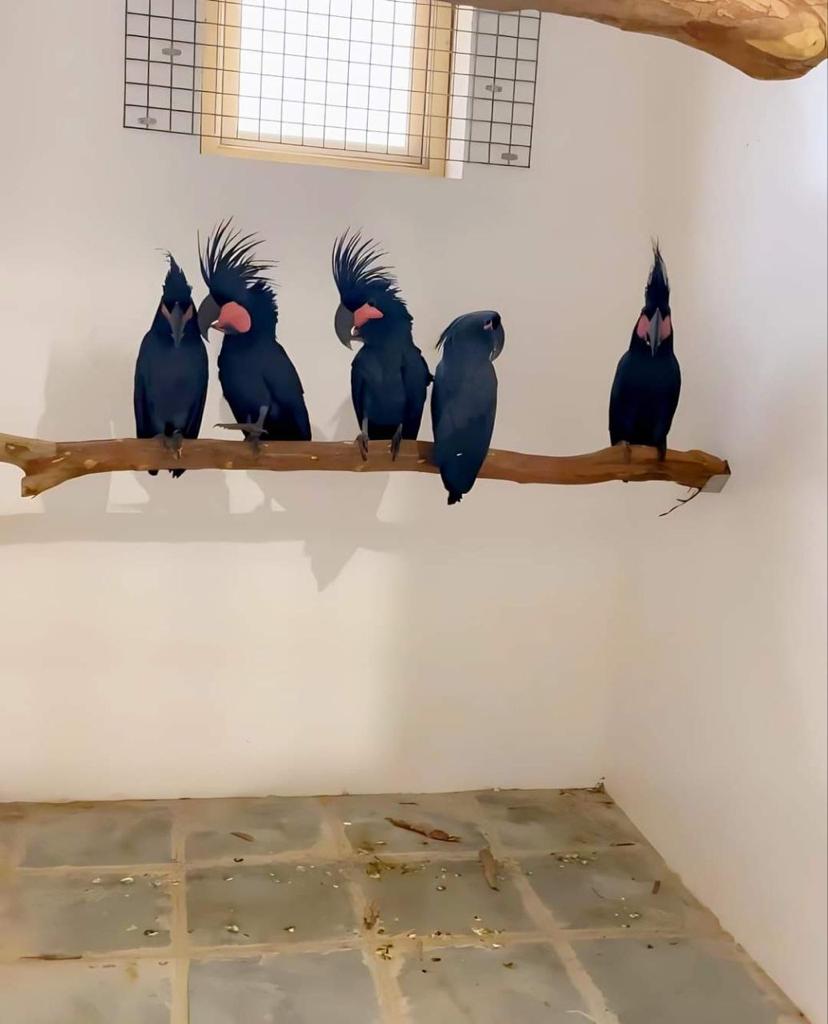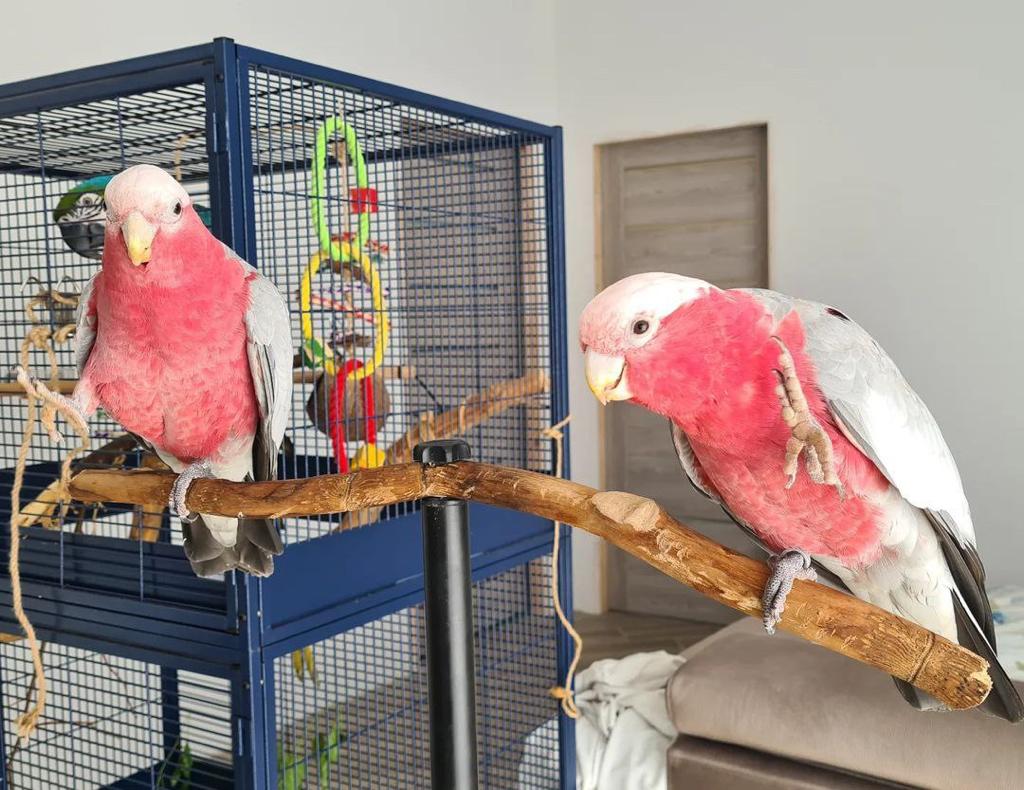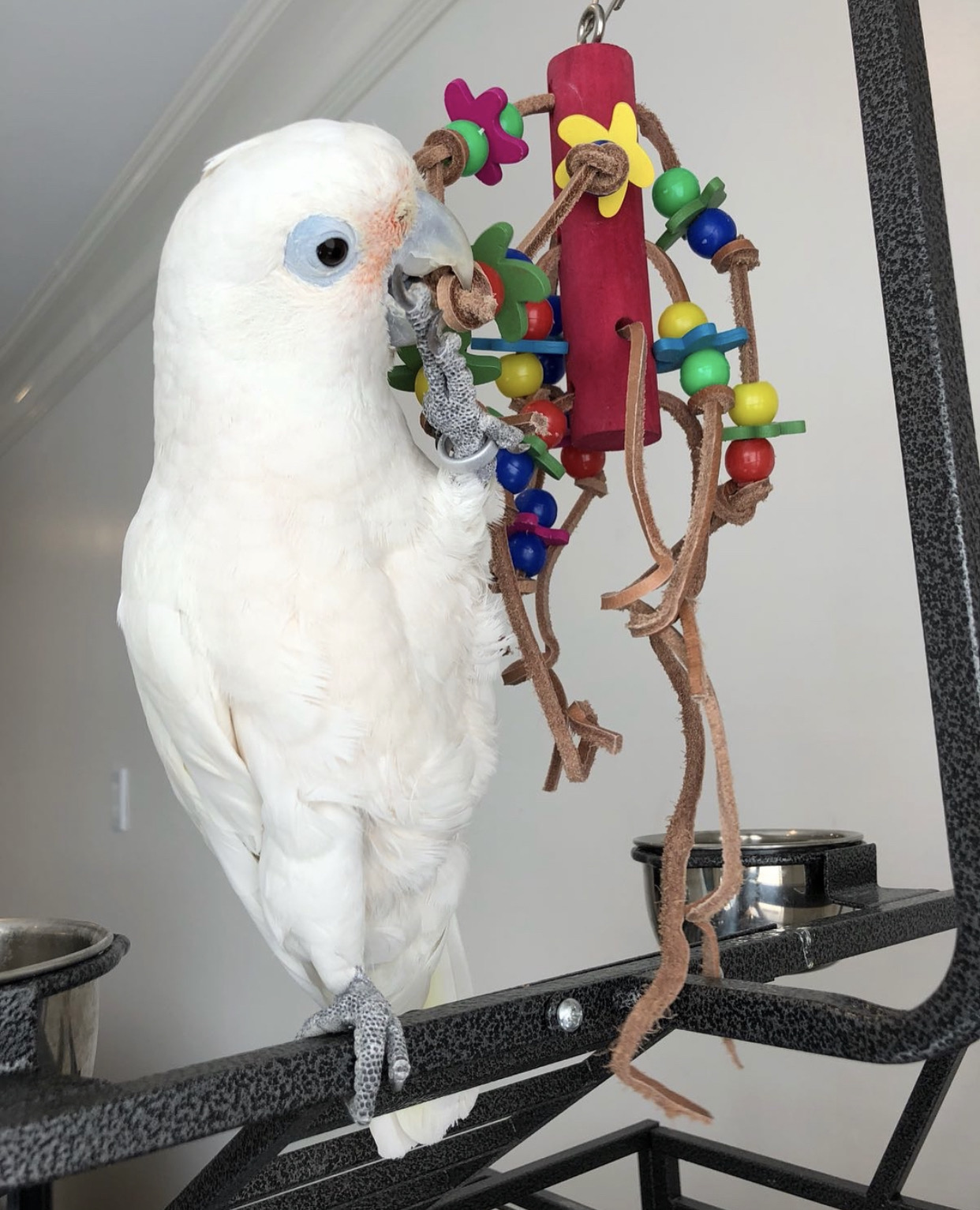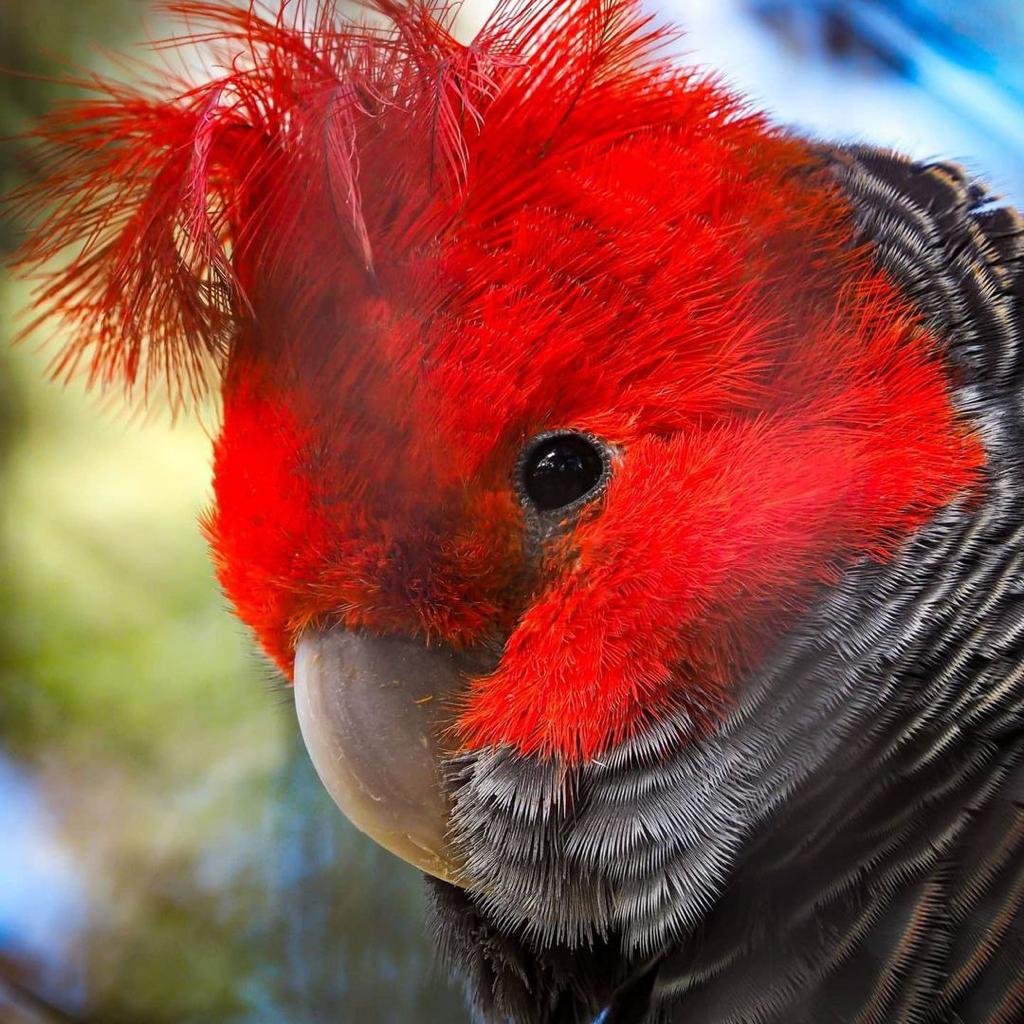Uncategorized
Best Cockatoos for Pets
Cockatoos are among the most charismatic and intelligent birds in the parrot family, making them popular choices for pet owners. However, each species has its unique traits and needs. Let’s explore the world of pet cockatoos, examining their characteristics, care requirements, and what makes them special companions.
The Majestic Black Palm Cockatoo
The Black Palm Cockatoo, also known as the Goliath Cockatoo, is truly a sight to behold. These birds are not just visually striking; they’re also known for their unique behaviors and impressive intelligence.
Physical Characteristics:
- Size: 55-65 cm (22-26 inches) in length
- Weight: 910-1200 g (2-2.6 lbs)
- Distinctive Features: Jet-black plumage, massive beak, and bright red cheek patches
Personality and Behavior:
Black Palm Cockatoos are gentle giants, known for their shy nature despite their imposing size. They’re highly intelligent and have been observed using tools in the wild, a rare trait among birds.
Care Requirements:
- Housing: Minimum cage size of 4m x 4m x 3m (13ft x 13ft x 10ft)
- Diet: High-quality pellets, variety of nuts, fruits, and vegetables
- Exercise: At least 3-4 hours of out-of-cage time daily
- Enrichment: Plenty of toys, especially those that challenge their problem-solving skills
Lifespan: 40-60 years in captivity, potentially up to 90 years with optimal care
The Cheerful Sulphur-crested Cockatoo
Sulphur-crested Cockatoos are among the most recognizable cockatoo species, known for their vibrant personalities and striking appearance.
Physical Characteristics:
- Size: 44-55 cm (17-22 inches) in length
- Weight: 815-975 g (1.8-2.1 lbs)
- Distinctive Features: Pure white plumage, bright yellow crest, and blue eye-ring
Personality and Behavior:
These cockatoos are extroverted and love being the center of attention. They’re known for their playful antics and ability to mimic human speech.
Care Requirements:
- Housing: Large cage or aviary, minimum 1m x 1m x 1.5m (3ft x 3ft x 5ft)
- Diet: Varied diet of high-quality pellets, fresh fruits and vegetables, and occasional nuts
- Exercise: Daily out-of-cage time for flying and climbing
- Enrichment: Plenty of toys for chewing and foraging, regular interaction with owners
Lifespan: 20-40 years in captivity, though some have been known to live up to 70 years
The Elegant Rose-breasted Cockatoo
Rose-breasted Cockatoos, also known as Galahs, are beloved for their beautiful coloration and charming personalities.
Physical Characteristics:
- Size: 35-38 cm (14-15 inches) in length
- Weight: 270-350 g (0.6-0.77 lbs)
- Distinctive Features: Pink breast and face, grey back and wings
Personality and Behavior:
Galahs are known for their playful and clownish behavior. They’re generally gentler and less demanding than some larger cockatoo species, making them popular pets.
Care Requirements:
- Housing: Cage size minimum 1m x 1m x 1m (3ft x 3ft x 3ft)
- Diet: Balanced diet of seeds, pellets, fresh fruits, and vegetables
- Exercise: Daily out-of-cage time for flying and exploration
- Enrichment: Variety of toys, especially those that encourage foraging behavior
Lifespan: 40-50 years in captivity
The Impressive Moluccan Cockatoo
Moluccan Cockatoos, with their stunning salmon-colored plumage, are often considered one of the most beautiful cockatoo species.
Physical Characteristics:
- Size: 46-52 cm (18-20.5 inches) in length
- Weight: 850-950 g (1.9-2.1 lbs)
- Distinctive Features: Salmon-pink feathers, large movable crest
Personality and Behavior:
These cockatoos are known for their extremely affectionate nature and strong desire for human interaction. They’re highly intelligent and can learn complex tricks and vocalizations.
Care Requirements:
- Housing: Large cage or aviary, minimum 1.5m x 1.5m x 2m (5ft x 5ft x 6.5ft)
- Diet: High-quality pellets, variety of fresh fruits and vegetables, occasional nuts
- Exercise: Several hours of out-of-cage time daily
- Enrichment: Constant supply of toys, puzzles, and activities to prevent boredom
Lifespan: 40-60 years in captivity, some individuals have lived up to 80 years
The Compact Goffin’s Cockatoo
Goffin’s Cockatoos, also known as Tanimbar Corellas, are smaller cockatoos known for their playful nature and problem-solving abilities.
Physical Characteristics:
- Size: 31-35 cm (12-14 inches) in length
- Weight: 250-350 g (0.55-0.77 lbs)
- Distinctive Features: White plumage with salmon-pink tinge, small rounded crest
Personality and Behavior:
These cockatoos are highly intelligent and curious, often surprising their owners with their ability to solve puzzles and manipulate objects.
Care Requirements:
- Housing: Cage size minimum 1m x 1m x 1m (3ft x 3ft x 3ft)
- Diet: Balanced diet of pellets, seeds, fresh fruits, and vegetables
- Exercise: Daily out-of-cage time for flying and exploration
- Enrichment: Variety of toys, especially those that challenge their problem-solving skills
Lifespan: 40-50 years in captivity
The Striking Major Mitchell’s Cockatoo
Major Mitchell’s Cockatoos, also known as Leadbeater’s Cockatoos, are renowned for their beautiful pink plumage and striking crest.
Physical Characteristics:
- Size: 33-37 cm (13-14.5 inches) in length
- Weight: 370-425 g (0.8-0.94 lbs)
- Distinctive Features: Pale pink body, multi-colored crest with red and yellow bands
Personality and Behavior:
These cockatoos are generally gentler and less demanding than some other species. They’re known for their sweet nature and ability to form strong bonds with their caregivers.
Care Requirements:
- Housing: Large cage or aviary, minimum 1.2m x 1.2m x 1.5m (4ft x 4ft x 5ft)
- Diet: High-quality pellets, variety of seeds, fresh fruits, and vegetables
- Exercise: Daily out-of-cage time for flying and climbing
- Enrichment: Plenty of toys for chewing and foraging, regular interaction with owners
Lifespan: 40-60 years in captivity
The Unique Gang-gang Cockatoo
Gang-gang Cockatoos are distinctive birds known for their unique appearance and relatively calm demeanor.
Physical Characteristics:
- Size: 32-37 cm (13-14.5 inches) in length
- Weight: 250-350 g (0.55-0.77 lbs)
- Distinctive Features: Grey body, males have a striking red head and crest
Personality and Behavior:
Gang-gang Cockatoos are generally quieter and more laid-back than many other cockatoo species. They’re known for their gentle nature and can make affectionate companions.
Care Requirements:
- Housing: Cage size minimum 1m x 1m x 1.5m (3ft x 3ft x 5ft)
- Diet: Varied diet of seeds, nuts, fruits, and vegetables
- Exercise: Regular out-of-cage time for flying and climbing
- Enrichment: Variety of toys, especially those that encourage foraging behavior
Lifespan: 40-50 years in captivity
The Classic Umbrella Cockatoo
Umbrella Cockatoos, also known as White Cockatoos, are one of the most popular cockatoo species in the pet trade.
Physical Characteristics:
- Size: 45-50 cm (18-20 inches) in length
- Weight: 750-900 g (1.65-2 lbs)
- Distinctive Features: All-white plumage, large rounded crest, black beak
Personality and Behavior:
Umbrella Cockatoos are known for their extremely affectionate nature and strong desire for human interaction. They’re intelligent birds capable of learning tricks and mimicking speech.
Care Requirements:
- Housing: Large cage or aviary, minimum 1.5m x 1.5m x 2m (5ft x 5ft x 6.5ft)
- Diet: High-quality pellets, variety of fresh fruits and vegetables, occasional nuts
- Exercise: Several hours of out-of-cage time daily
- Enrichment: Constant supply of toys, puzzles, and activities to prevent boredom
Lifespan: 50-60 years in captivity, some individuals have lived up to 70-80 years
Caring for Your Cockatoo
Regardless of the species you choose, all cockatoos require dedicated care to thrive as pets. Here are some key considerations:
- Housing: Provide a spacious cage or aviary with plenty of room for movement and play.
- Diet: Offer a varied diet of high-quality pellets, fresh fruits and vegetables, and occasional treats.
- Enrichment: Supply a variety of toys and activities to keep your cockatoo mentally stimulated.
- Social Interaction: Dedicate several hours each day to interacting with your cockatoo.
- Health Care: Regular check-ups with an avian veterinarian are essential.
- Training: Consistent, positive reinforcement training is crucial for developing a well-behaved cockatoo.
- Exercise: Ensure your cockatoo gets plenty of exercise through flight and climbing opportunities.
- Grooming: Regular bathing opportunities and occasional nail and beak trims are important.
Remember, owning a cockatoo is a long-term commitment, often spanning several decades. Choose wisely and provide the best care possible for these magnificent birds.








